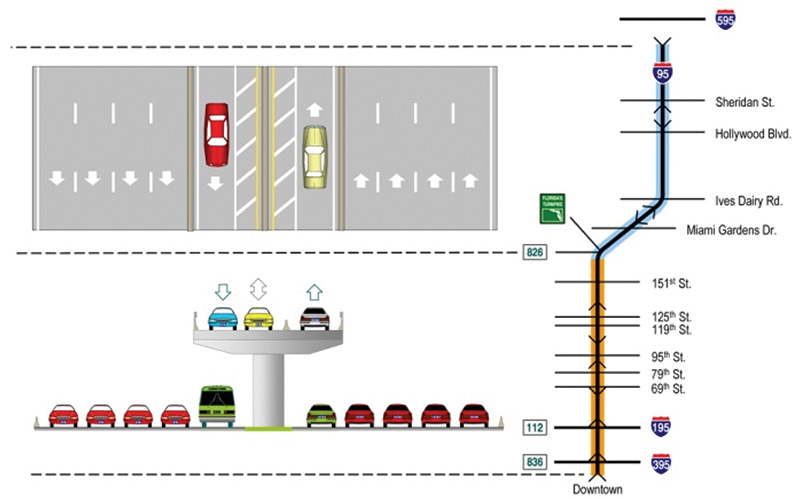Transportation Systems Management and Operations and Performance Based Practical Design Case Study 1: Demonstrating Performance-Based Practical Design through Analysis of High-Occupancy Toll Lanes
Printable Version [PDF, 364 KB]
U.S. Department of Transportation Publication #: FHWA HOP-16-040 August 2016 Purpose of the Transportation Systems Management and Operations Performance-Based Practical Design Case Study Series and Summary of Case Study 1As states and local agencies become increasingly challenged with addressing their system performance, mobility, and safety needs in the current era of financial limitations, Federal Highway Administration (FHWA) is providing guidance, delivering technical assistance, and sharing resources related to performance-based practical design (PBPD; source: FHWA). The FHWA Office of Operations is supporting the overall Agency PBPD effort by highlighting the role Transportation Systems Management and Operations (TSMO) alternatives and analysis tools can play in supporting PBPD. To illustrate the range of TSMO strategies and how they are applied by transportation planners and designers in a PBPD context, FHWA has developed five case studies. This Case Study 1 illustrates how PBPD can be applied by analyzing managed freeway lanes on a congested urban corridor and focuses on using high-occupancy toll (HOT) lanes to improve urban freeway travel and reliability. It reinforces applying a PBPD approach by drawing on various performance related analyses conducted for a HOT lane project in Florida. The other case studies include urban freeway reconstruction and modernization, use of alternative intersections on arterials, regional performance-based planning, and PBPD during active traffic management (ATM) design and implementation. Case Study BackgroundMany heavily travelled urban freeway corridors experience severe recurring congestion, but traditional widening projects are not feasible due to limited financial resources, limited right-of-way, or both. Agencies operating such facilities often employ strategies such as traffic incident management and provide traveler information, but the capacity and reliability impacts of these strategies is limited, particularly with regard to recurring congestion. This case study highlights a recently-constructed project on Interstate 95 (I-95) in Miami. Traditional and TSMO-oriented alternatives were developed and evaluated in a manner consistent the PBPD approach.
A 21-mile section of I-95 between Interstate 395 (I-395) in Miami
and Interstate 595 (I 595) in Fort Lauderdale suffers from reduced
travel speeds, large variability in trip times, and limited throughput
during peak periods. As a result, the Florida Department of
Transportation (FDOT) and Miami-Dade Metropolitan Transportation
Planning Organization (MPO) sought to identify strategies to help
improve traffic flow and travel time reliability along the corridor,
which featured four general-purpose lanes and a single high-occupancy
-vehicle (HOV) lane in each direction. Before the study, the HOV lanes
only operated during peak periods.
Corridor and System Needs and ObjectivesPBPD strengthens the emphasis on planning-level corridor or system performance needs and objectives when planning, scoping, and developing individual projects.To provide meaningful improvements to a congested freeway, comprehensively analyzing and improving a long segment rather than short portions is sometimes necessary. Undertaking spot improvements and other projects that only target the localized issues lead to marginally effective solutions for corridors as a whole. Spot improvements may transfer bottlenecks to other locations and have a minimal net improvement. A PBPD scope includes assessment of localized issues and corridor-wide issues of a more regional nature. Performance ImprovementsPBPD focuses on performance improvements that benefit both project and system needs.PBPD makes the best use of limited available financial resources. Projects are scoped to achieve, but not vastly exceed, identified needs.
The Miami-Dade MPO and FDOT set out to develop a wide range of context-
sensitive solutions, placing priorities on maximizing throughput, increasing
travel time reliability, and encouraging using trip-reducing transportation
modes. Most importantly, solutions identified early in the planning stages
were not resolute in nature; the concepts were high level and would be refined
based on the findings of a detailed performance analysis.
Performance AnalysisAgencies make sound decisions based upon performance analysis.
The Miami-Dade MPO developed six alternative solutions, focusing their mitigation
strategies on improving the managed lanes within the facility. These alternatives
ranged from simply converting HOV lanes to HOT operations to constructing a
multilane elevated roadway. To determine which alternative would best meet the
study goals, FDOT conducted a performance evaluation of the six alternatives. This
required analyzing daily and hourly traffic variations, vehicle occupancy rates,
travel patterns and characteristics, and historical traffic trends. In addition,
extensive speed-delay runs were made during peak, off-peak, and shoulder-hour
conditions along I-95. In all, the performance evaluation included the following:
Analysis should be conducted for multiple alternatives so that the relative benefits can be compared. PBPD identifies projects that achieve project needs through analysis. Greater Return on InvestmentsBy scrutinizing each element of a project's scope relative to value, need, and urgency, a PBPD approach seeks a greater return on infrastructure investments.When meeting the full performance goals is cost-prohibitive, there are some times opportunities to greatly improve operational performance at a relatively lower cost. For example, adding one lane though a bottleneck may improve level of service from an unacceptable to acceptable level for many hours a day, but still have unacceptable operations one hour a day. If adding two lanes is prohibitively expensive, one lane could possibly be added with a PBPD approach to allow those benefits to be realized. The I-95 project illustrates how several performance measures are often needed to scrutinize each project element and identify the greatest return on investments.
After conducting a preliminary performance analysis for each alternative,
FDOT ranked each based on the following:

Figure 1. Graphic. Elevated Managed Lanes Alternative. Design Standards and Regulatory RequirementsPBPD can be implemented within the Federal-aid Highway Program regulatory environment utilizing existing flexibility. PBPD does not eliminate, modify, or compromise existing design standards or regulatory requirements.Although PBPD may lead to more thorough and effective vetting of potential alternatives, agencies are not exempt from adhering to state and federal regulatory standards governing selection of alternative solutions. National Environmental Policy Act (NEPA) documentation is still required, and existing NEPA decision-making regulations remain. In addition to environmental regulations, alternatives are subject to design standards and exceptions must be documented if minimum controlling criteria are not met.
On I-95, FDOT ultimately selected an alternative with all lanes on the existing
grade (no elevated lanes). Lanes were narrowed to 11 feet, and shoulders were also
narrowed below American Association of State Highway and Transportation Officials
minimum values. The project required a design exception. The completed project is
shown in Figure 2.

Figure 2. Graphic. Completed Project with Performance-Based Practical Design Alternative Constructed. Performance-Based Practical DesignPBPD encourages evaluation of the performance impacts of highway design decisions relative to the cost of providing various design features. PBPD can be articulated as modifying a traditional design approach from a "top-down," standards-first approach to a "design-up" approach, where decision- makers exercise engineering judgment to build upon the improvements from existing conditions to meet both project and system objectives. PBPD uses appropriate performance-analysis tools and considers both short- and long-term project and system goals while addressing project purpose and need. Following a PBPD approach can make using scarce resources more efficient so that more improvements can be made and overall transportation system performance exceeds the performance that would have otherwise been achieved if the focus was on individual project-based (as opposed to systems-based) decisions. Following are notable PBPD attributes:
PBPD can be implemented within the Federal-aid Highway Program regulatory environment utilizing existing flexibility. PBPD does not eliminate, modify, or compromise existing design standards or regulatory requirements. ContactsGeorge Merritt
Jim Hunt
Robert Mooney
|
|
United States Department of Transportation - Federal Highway Administration |
||